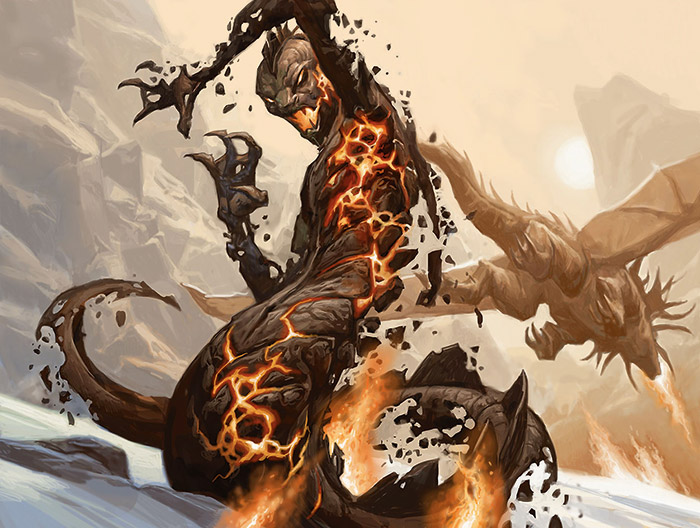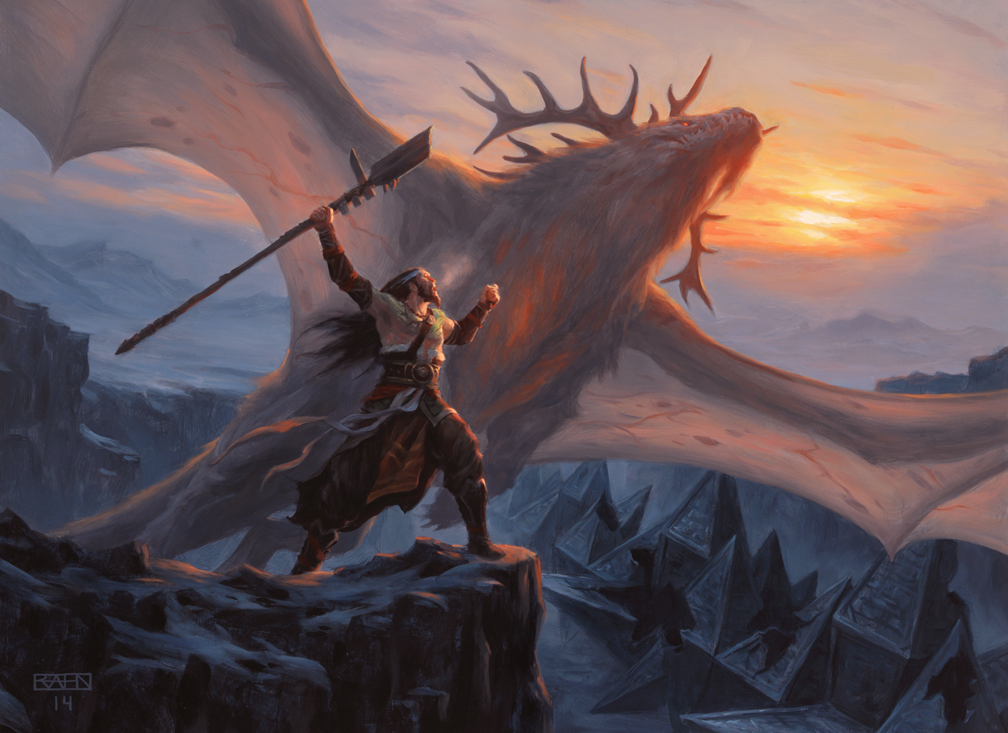Welcome back to Magic Gatherings! We’re trying something a little different this week.
As you may have heard (because I have been mentioning preview cards for the last two weeks), Dragons of Tarkir is on the way, and this weekend stores around the world will be hosting prerelease tournaments to give players a new chance to play with the cards. With that in mind, we’re going to look at the set from the perspective of limited magic.
(Multiplayer/casual readers: I still love you! Next week I’ll be back to form, to wrap up themes. But variety is spicy, as they say.)
One thing I may not have mentioned in my previous articles is that I love limited. I have only rarely toted a Standard deck to a sanctioned event, but have often sleeved up forty cards for battle. So this kind of article is a treat for me. If you like it and want more, let me know!
If you’re unfamiliar with limited formats, or new to prereleases in general, do yourself a favor and check out WotC’s Prerelease Primer. That article also links to several limited-focused articles by Reid Duke, who is writing an excellent “fundamentals” series on the WotC website. I can’t recommend it highly enough if you are interested in developing your understanding of the game.
For this review, I won’t address every card individually. Those articles make for good reading, but magic expert Luis Scott-Vargas has that angle covered, and he can evaluate power level a lot better than I can. The other reason, of course, is that cards never actually operate in a vacuum. What cards are good and bad is going to be influenced by what the set allows and encourages. (In addition to LSV’s articles, I have also read Ari Lax’s assessment on Star City Games—it’s premium-only, but if you have access his insight is worth it. There is also Marshall Sutcliffe’s review of the mechanics of Dragons of Tarkir.)
Instead, we’re going to look broadly at the commons and uncommons of Dragons of Tarkir to see what emerges: what powers and toughnesses are important? what play patterns emerge? That will help you parse your sealed pool and build your deck with a plan in mind—and in my experience, having a plan is the most important thing you can have.
Let’s jump right in with the set of cards that will form a major part of limited play.
Megamorphs
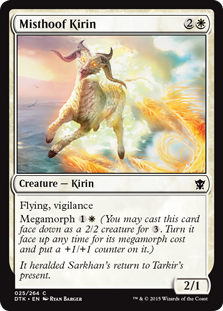
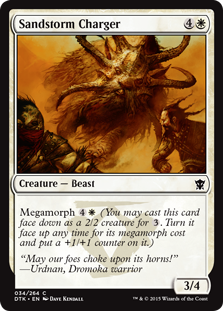
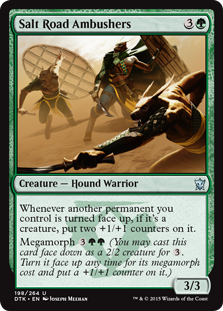
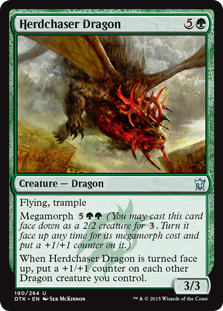
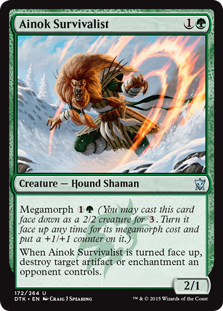

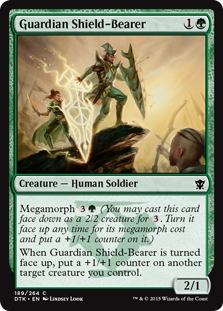
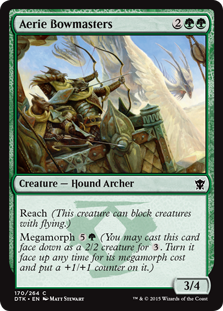
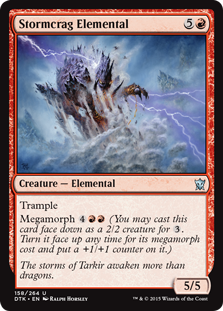


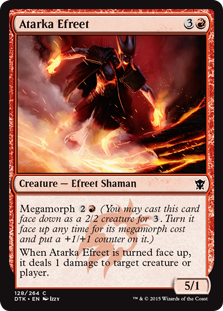
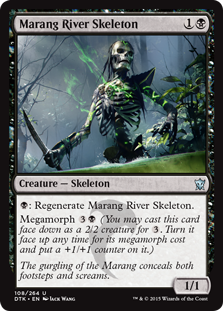
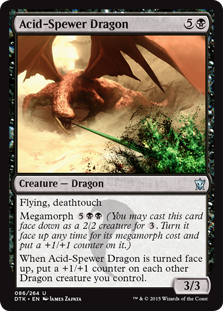


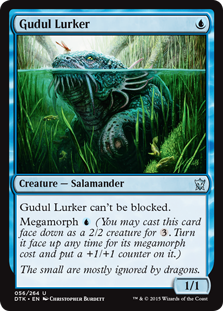
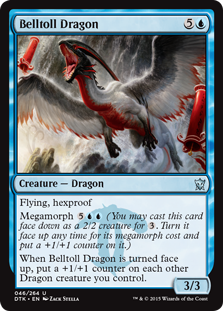
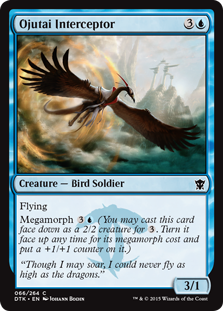
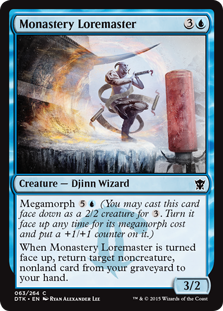


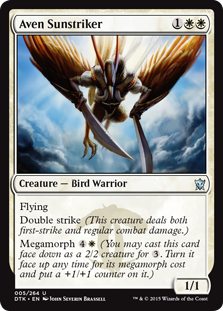 There are slightly fewer megamorphs in Dragons than there were morphs in Khans. Taking both commons and uncommons into account, there will be an average of right around three megamorphs per drafter in Dragons drafts. That’s down from about 3.4 per drafter in Fate-Khans-Khans drafts. The presence is lower at common (11 DTK vs. 17 KTK), but higher at uncommon (11 DTK vs. 9 KTK).
There are slightly fewer megamorphs in Dragons than there were morphs in Khans. Taking both commons and uncommons into account, there will be an average of right around three megamorphs per drafter in Dragons drafts. That’s down from about 3.4 per drafter in Fate-Khans-Khans drafts. The presence is lower at common (11 DTK vs. 17 KTK), but higher at uncommon (11 DTK vs. 9 KTK).
On the other hand, because Dragons is designed for two-color draft, you won’t need morphs to “colorfix” your draws as often, and can expect to have more latitude to play attractive on-color creatures at similar points on the mana curve. By the same token, you shouldn’t have to fight quite as hard for them in draft, though the megamorphs tend to be attractive creatures in their own right, beyond just being bodies to fill the curve.
Megamorphs still obey the “five mana” rule—that is, your morph won’t win combat with another morph if you pay less than five mana to unmorph it. They also are sized similarly to the Khans morphs—lots of 4/x creatures, with a few “breakers” in [mtg_card]Marsh Hulk[/mtg_card], [mtg_card]Segemented Krotiq[/mtg_card], and [mtg_card]Stormcrag Elemental[/mtg_card] (an uncommon). [mtg_card]Aerie Bowmasters[/mtg_card] and [mtg_card]Sandstorm Charger[/mtg_card] are especially attractive as 4/5s in that world. [mtg_card]Ojutai Interceptor[/mtg_card] also gets special mention, as it flips into a 4/2 that can tussle with dragons (at the cost of dying to most other flyers in the set). Most non-morphs have only two power, so as with Khans limited, few non-morphs can engage a creature that has flipped face-up. 2, 4, and 5 are looking like important numbers for this set, then.
There do seem to be slightly fewer megamorphs that truly frustrate early aggression, as [mtg_card]War Behemoth[/mtg_card], [mtg_card]Glacial Stalker[/mtg_card], [mtg_card]Abzan Guide[/mtg_card], et al. often did in KTK drafts. Loading up on two-drops was dangerous in that format, as your opponent would never stumble (they’d always have a morph on turn three to trade with your two-drop), and their morphs would often flip up on turn five or six as a brick wall against your 2/1s.
That means that aggressive strategies will be a little better off in Dragons than they were in Khans. [mtg_card]Sandstorm Charger[/mtg_card] and [mtg_card]Aerie Bowmasters[/mtg_card] do their best, but it is definitely easier to get through a 4/3 [mtg_card]Monastery Loremaster[/mtg_card] than it was to get through [mtg_card]Glacial Stalker[/mtg_card]. [mtg_card]Segmented Krotiq[/mtg_card] and [mtg_card]Marsh Hulk[/mtg_card] are large, but flipping up on seven mana is a lot worse than flipping on six. By extension, having slightly fewer profitable things to unmorph on turn five makes cards like [mtg_card]Stampeding Elk Herd[/mtg_card] more attractive.
That said, the Dragons megamorphs strike me as having additional upsides for morphing, moreso than the Khans morphs did. [mtg_card]Monastery Loremaster[/mtg_card] and [mtg_card]Ainok Survivalist[/mtg_card] are pretty much guaranteed card advantage, and [mtg_card]Silumgar Spell-Eater[/mtg_card] is a reasonable bet. [mtg_card]Atarka Efreet[/mtg_card] and [mtg_card]Guardian Shield-Bearer[/mtg_card] have flip-up abilities that are each worth a substantial portion of a card, which is a good deal to get for free.
The Removal
In keeping with precedent established by recent sets, the common removal in this set is narrow at two and three mana and generally solid (but expensive) at five mana.
The exceptions to this rule will be among your top picks, and here I’m especially looking at [mtg_card]Pacifism[/mtg_card], [mtg_card]Reduce in Stature[/mtg_card], and [mtg_card]Flatten[/mtg_card]. Few common cards in this set unconditionally kill something, but [mtg_card]Pacifism[/mtg_card] and [mtg_card]Reduce[/mtg_card] do a good impression. [mtg_card]Flatten[/mtg_card] kills the uncommon dragons, which will be a big deal, as not many other things do. [mtg_card]Epic Confrontation[/mtg_card] and [mtg_card]Tail Swipe[/mtg_card] also count, though they’re obviously a bit less reliable.
Watch out against blue and black players, though—Exploit gives them something very good to do with a [mtg_card]Pacifism[/mtg_card]-ed creature. The various +1/+1 counters running around make Reduce even more awkward, though probably not so much that it’s wrong to play it.
Things improve at uncommon, where there’s a lot of two mana removal. You have the color-hosers: [mtg_card]Surge of Righteousness[/mtg_card], [mtg_card]Encase in Ice[/mtg_card], [mtg_card]Self-Inflicted Wound[/mtg_card], and [mtg_card]Rending Volley[/mtg_card]. They’re all good against the appropriate colors, though maybe too narrow to maindeck. [mtg_card]Silumgar Sorcerer[/mtg_card] counts (and is a great card, to boot). [mtg_card]Roast[/mtg_card] will be amazing.
That said, a lot of this removal seems to have real issues killing a dragon. [mtg_card]Silkwrap[/mtg_card] is a solid card, but dragons are too big for scarves. Ditto for the otherwise excellent [mtg_card]Draconic Roar[/mtg_card]. Most of them are multicolored, so [mtg_card]Ultimate Price[/mtg_card] won’t get the job done.
Instead, you’ve got [mtg_card]Pacifism[/mtg_card], [mtg_card]Reduce in Stature[/mtg_card], [mtg_card]Flatten[/mtg_card], plus some expensive cards in [mtg_card]Sarkhan’s Rage[/mtg_card] and [mtg_card]Death Wind[/mtg_card]. [mtg_card]Enduring Victory[/mtg_card] counts, since that dragon will eventually attack, but five mana is a lot to hold up and good players can find ways to punish you for doing that. Ditto for [mtg_card]Pinion Feast[/mtg_card].
What this means is that you should be extra careful to use the right removal spell for the right threat. Your dragon-killers will be premium spells, so hold them if you can. You may also need to kill opposing dragons with your own, in an epic dragon-versus-dragon fight in the skies above Tarkir. That brings us to….
The Combat Tricks
The combat tricks in this set seem particularly good. At common White has [mtg_card]Artful Maneuver[/mtg_card], which is great, and [mtg_card]Glaring Aegis[/mtg_card] looks like it can do good work in the right deck. [mtg_card]Center Soul[/mtg_card] will be a useful one to have, and to know about. At uncommon, [mtg_card]Great Teacher’s Decree[/mtg_card] is twice the [mtg_card]Rush of Battle[/mtg_card] for twice the fun. Note that [mtg_card]Strongarm Monk[/mtg_card] does similar work, and gives another reason to go wide with a large number of creatures.
Black has [mtg_card]Coat with Venom[/mtg_card], which should win most two-drop vs. three-drop fights while leaving you with tons of mana to advance your board. [mtg_card]Butcher’s Glee[/mtg_card] is most of a [mtg_card]Necrobite[/mtg_card], and the lifegain will put you ahead if you are racing your opponent. Red has a card similar to [mtg_card]Coat with Venom[/mtg_card] in [mtg_card]Kindled Fury[/mtg_card], plus a more expensive [mtg_card]Trumpet Blast[/mtg_card]. In green, [mtg_card]Tread Upon[/mtg_card] and [mtg_card]Press the Advantage[/mtg_card] look very good.
Blue doesn’t have tricks per se, but it does have tons of tempo. Between [mtg_card]Ojutai’s Breath[/mtg_card], [mtg_card]Taigam’s Strike[/mtg_card], and [mtg_card]Elusive Spellfist[/mtg_card], there are an unusually high number of tools to force the last points of damage through. [mtg_card]Gudul Lurker[/mtg_card], [mtg_card]Elusive Spellfist[/mtg_card], and [mtg_card]Void Squall[/mtg_card] help too. Remember that [mtg_card]Will of the Naga[/mtg_card] is also in the format.
Particularly good combat tricks, once again, mean that aggressive strategies should be a little bit better off. Most of these won’t let your 2/2 get a dragon, but you can gain value in the early game while continuing to advance your board. If you pull that off, the dragon might not be able to stop enough creatures to matter.
The Mana
This is one of the most subtle differences, but it’s also one of the most important. There are no more tri-lands. Gone are packs with multiple taplands at common. You will get one land per pack in Fate Reforged. Then you have [mtg_card]Evolving Wilds[/mtg_card]. That’s it.
What that means is that two-color decks will be the norm, since your mana won’t support anything else. No more three-color or three-color-with-a-little-splash. No more, I say to five-color, as a tear runs down my cheek. Occasionally you will splash one or two removal spells, or maybe a dragon, on sheer power level, but you should make sure your main colors are squared away, as you will need to cast spells to keep up.
That’s because fewer fixing lands makes for an important corollary: games will develop much more quickly in DTK limited than they did in KTK. In the latter format, both players often had taplands on turn one, and sometimes even on turn two. Board development sometimes stalled because one player was missing a color.
In Dragons limited, few players will have taplands, which means board development will proceed more regularly: you’ll often have a two drop, then a morph. Falling behind because you don’t have the right colors to cast your spells will be a serious problem. This also pushes the format in a more aggressive direction than we saw with Khans limited. The bottom line: don’t get too greedy with your mana, and be prepared to contest the early game.
Also, don’t be like me and misread [mtg_card]Sheltered Aerie[/mtg_card]: you don’t get two extra mana when you tap that card, so the acceleration is not as good as it might appear at first.
The Dragons
Dragons look to be another major player in the limited format—as you might expect, given the set’s name. There are 26 dragons in all—11 uncommon (five multicolor, five single-color megamorphs, and [mtg_card]Scion of Ugin[/mtg_card]), 10 rare (five multicolor, plus five monocolor Regents), and 5 mythic (the Elder Dragonlors). That’s an average of about 10 per draft—13, if you count the uncommon Monument cycle ([mtg_card]Atarka Monument[/mtg_card] et al.), which are conditional dragons.
Not every deck will want to play all those dragons, especially in draft—I can certainly see an aggressive deck choosing to stop its curve at four or five, perhaps with a megamorph lurking in the three-drops. That means that slower decks which expect to reach six mana should have two, maybe three dragons apiece. Particularly in sealed, at the prerelease, dragons will be a draw toward their colors, and I suspect most people will want to play the ones they open. (It also wouldn’t surprise me to see Wizards collate the seeded prerelease pack such that you always get a dragon or two.)
WotC’s internal documents suggest that they didn’t want the limited games to come down to “first dragon wins” or “last dragon wins”—though they were aware the latter might happen a decent amount. 4/4 flyers are tough to beat. Make sure you hang on to the removal that does kill dragons, and have a plan for getting through or around them if your deck is more aggressive. If you’re the dragon-master (though perhaps not the Dragonmaster), do your best to stall the ground or trade off smaller creatures, so that your dragon can rule the game when you get the chance to cast it. Dragons shouldn’t dominate every game, and may not even show up in some, but it’s important to keep them in mind.
The Bottom Line
In his set review, Ari Lax calls Dragons of Tarkir “a beatdown world.” That seems a bit extreme to me, though being aggressive is certainly better in Dragons than it was in Khans, and it’s clear that your deck should bring a clear plan to the table—probably a proactive one. A deck of two- and three-mana creatures which draws the right mix of tricks and removal has a good shot of getting ahead and staying ahead. As Lax says, two is the key power and four looks like the key toughness—five is good too, for your [mtg_card]Aerie Bowmasters[/mtg_card] and [mtg_card]Sandstorm Charger[/mtg_card]s.
If you want to play for a more controlling strategy, pay close attention to the 2/4s, especially [mtg_card]Gurmag Drowner[/mtg_card] and [mtg_card]Student of Ojutai[/mtg_card]. [mtg_card]Updraft Elemental[/mtg_card], and the various 1/3s running around, can do some solid work as well. At uncommon, [mtg_card]Ukud Cobra[/mtg_card] looks stellar.
Exploit is definitely an attractive ability here, which says good things about the set design. Your 1/3s and 0/4s primarily exist to save damage against aggressive decks on turns two through five. Once they’ve done that, your better exploit creatures can cash them in for removal spells and card draw. That said, an awkward exploit draw will be tough to win with; [mtg_card]Gurmag Drowner[/mtg_card] will be sad on the draw against an opponent who curves out, as you probably won’t be able to trade board presence away to make use of Exploit.
I’m more bullish on controlling strategies in sealed, since it’s harder for an aggressive deck to get the perfect mix of tricks, removal, and effective threats. Plus, lots of the Exploit abilities draw cards. So do some creatures, when they die—take [mtg_card]Palace Familiar[/mtg_card] and [mtg_card]Youthful Scholar[/mtg_card]. It makes for a good way to reach your bombs.
For the prerelease this weekend, I’ll probably choose blue, leaving myself open to a blue-black Exploit deck or a blue-white tempo deck. Both are styles I like to play, and both seem strong in this set. Green has lots of good creatures at common, so it’s hard to go wrong there. Red and black both have dash; Mardu has tended to do well at our last few prereleases, so you could have success with a strong pool there. I’m not as interested in White, as a base color—there’s a lot of smaller creatures, which are generally worse in sealed than in draft, and it seems distinctly possible to get an awkward mix of offensive and defensive stuff.
That’s what I have to say about Dragons of Tarkir limited. What are your thoughts? Am I wildly off base? Did I forget to mention a card you’re excited to play? Let me know in the comments!

